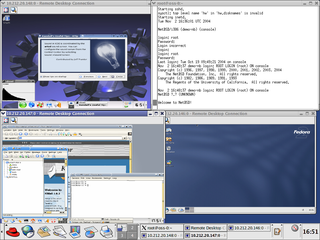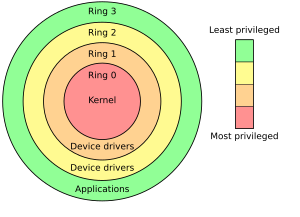
In computing, virtual memory, or virtual storage, is a memory management technique that provides an "idealized abstraction of the storage resources that are actually available on a given machine" which "creates the illusion to users of a very large (main) memory".
A modern computer operating system usually uses virtual memory to provide separate address spaces called user space and kernel space. Primarily, this separation serves to provide memory protection and hardware protection from malicious or errant software behaviour.

In computing, a system call is the programmatic way in which a computer program requests a service from the operating system on which it is executed. This may include hardware-related services, creation and execution of new processes, and communication with integral kernel services such as process scheduling. System calls provide an essential interface between a process and the operating system.
x86 memory segmentation refers to the implementation of memory segmentation in the Intel x86 computer instruction set architecture. Segmentation was introduced on the Intel 8086 in 1978 as a way to allow programs to address more than 64 KB (65,536 bytes) of memory. The Intel 80286 introduced a second version of segmentation in 1982 that added support for virtual memory and memory protection. At this point the original mode was renamed to real mode, and the new version was named protected mode. The x86-64 architecture, introduced in 2003, has largely dropped support for segmentation in 64-bit mode.
In computing, protected mode, also called protected virtual address mode, is an operational mode of x86-compatible central processing units (CPUs). It allows system software to use features such as segmentation, virtual memory, paging and safe multi-tasking designed to increase an operating system's control over application software.

x86-64 is a 64-bit version of the x86 instruction set, first announced in 1999. It introduced two new modes of operation, 64-bit mode and compatibility mode, along with a new 4-level paging mode.
Memory protection is a way to control memory access rights on a computer, and is a part of most modern instruction set architectures and operating systems. The main purpose of memory protection is to prevent a process from accessing memory that has not been allocated to it. This prevents a bug or malware within a process from affecting other processes, or the operating system itself. Protection may encompass all accesses to a specified area of memory, write accesses, or attempts to execute the contents of the area. An attempt to access unauthorized memory results in a hardware fault, e.g., a segmentation fault, storage violation exception, generally causing abnormal termination of the offending process. Memory protection for computer security includes additional techniques such as address space layout randomization and executable-space protection.

A general protection fault (GPF) in the x86 instruction set architectures (ISAs) is a fault initiated by ISA-defined protection mechanisms in response to an access violation caused by some running code, either in the kernel or a user program. The mechanism is first described in Intel manuals and datasheets for the Intel 80286 CPU, which was introduced in 1983; it is also described in section 9.8.13 in the Intel 80386 programmer's reference manual from 1986. A general protection fault is implemented as an interrupt. Some operating systems may also classify some exceptions not related to access violations, such as illegal opcode exceptions, as general protection faults, even though they have nothing to do with memory protection. If a CPU detects a protection violation, it stops executing the code and sends a GPF interrupt. In most cases, the operating system removes the failing process from the execution queue, signals the user, and continues executing other processes. If, however, the operating system fails to catch the general protection fault, i.e. another protection violation occurs before the operating system returns from the previous GPF interrupt, the CPU signals a double fault, stopping the operating system. If yet another failure occurs, the CPU is unable to recover; since 80286, the CPU enters a special halt state called "Shutdown", which can only be exited through a hardware reset. The IBM PC AT, the first PC-compatible system to contain an 80286, has hardware that detects the Shutdown state and automatically resets the CPU when it occurs. All descendants of the PC AT do the same, so in a PC, a triple fault causes an immediate system reset.

Xen is a free and open-source type-1 hypervisor, providing services that allow multiple computer operating systems to execute on the same computer hardware concurrently. It was originally developed by the University of Cambridge Computer Laboratory and is now being developed by the Linux Foundation with support from Intel, Citrix, Arm Ltd, Huawei, AWS, Alibaba Cloud, AMD, Bitdefender and epam.
In the 80386 microprocessor and later, virtual 8086 mode allows the execution of real mode applications that are incapable of running directly in protected mode while the processor is running a protected mode operating system. It is a hardware virtualization technique that allowed multiple 8086 processors to be emulated by the 386 chip. It emerged from the painful experiences with the 80286 protected mode, which by itself was not suitable to run concurrent real-mode applications well. John Crawford developed the Virtual Mode bit at the register set, paving the way to this environment.
x86 virtualization is the use of hardware-assisted virtualization capabilities on an x86/x86-64 CPU.
A hypervisor, also known as a virtual machine monitor (VMM) or virtualizer, is a type of computer software, firmware or hardware that creates and runs virtual machines. A computer on which a hypervisor runs one or more virtual machines is called a host machine, and each virtual machine is called a guest machine. The hypervisor presents the guest operating systems with a virtual operating platform and manages the execution of the guest operating systems. Unlike an emulator, the guest executes most instructions on the native hardware. Multiple instances of a variety of operating systems may share the virtualized hardware resources: for example, Linux, Windows, and macOS instances can all run on a single physical x86 machine. This contrasts with operating-system–level virtualization, where all instances must share a single kernel, though the guest operating systems can differ in user space, such as different Linux distributions with the same kernel.
CPU modes are operating modes for the central processing unit of most computer architectures that place restrictions on the type and scope of operations that can be performed by instructions being executed by the CPU. For example, this design allows an operating system to run with more privileges than application software by running the operating systems and applications in different modes.
A call gate is a mechanism in Intel's x86 architecture for changing the privilege level of a process when it executes a predefined function call using a CALL FAR instruction.
The following is a timeline of virtualization development. In computing, virtualization is the use of a computer to simulate another computer. Through virtualization, a host simulates a guest by exposing virtual hardware devices, which may be done through software or by allowing access to a physical device connected to the machine.

In computer science, full virtualization (fv) is a modern virtualization technique developed in late 1990s. It is different from simulation and emulation. Virtualization employs techniques that can create instances of a virtual environment, as opposed to simulation, which models the environment; and emulation, which replicates the target environment with certain kinds of virtual environments called emulation environments for virtual machines. Full virtualization requires that every salient feature of the hardware be reflected into one of several virtual machines – including the full instruction set, input/output operations, interrupts, memory access, and whatever other elements are used by the software that runs on the bare machine, and that is intended to run in a virtual machine. In such an environment, any software capable of execution on the raw hardware can be run in the virtual machine and, in particular, any operating systems. The obvious test of full virtualization is whether an operating system intended for stand-alone use can successfully run inside a virtual machine.

The kernel is a computer program at the core of a computer's operating system and generally has complete control over everything in the system. The kernel is also responsible for preventing and mitigating conflicts between different processes. It is the portion of the operating system code that is always resident in memory and facilitates interactions between hardware and software components. A full kernel controls all hardware resources via device drivers, arbitrates conflicts between processes concerning such resources, and optimizes the utilization of common resources e.g. CPU & cache usage, file systems, and network sockets. On most systems, the kernel is one of the first programs loaded on startup. It handles the rest of startup as well as memory, peripherals, and input/output (I/O) requests from software, translating them into data-processing instructions for the central processing unit.
Supervisor Mode Access Prevention (SMAP) is a feature of some CPU implementations such as the Intel Broadwell microarchitecture that allows supervisor mode programs to optionally set user-space memory mappings so that access to those mappings from supervisor mode will cause a trap. This makes it harder for malicious programs to "trick" the kernel into using instructions or data from a user-space program.
In computing, a system virtual machine is a virtual machine (VM) that provides a complete system platform and supports the execution of a complete operating system (OS). These usually emulate an existing architecture, and are built with the purpose of either providing a platform to run programs where the real hardware is not available for use, or of having multiple instances of virtual machines leading to more efficient use of computing resources, both in terms of energy consumption and cost effectiveness, or both. A VM was originally defined by Popek and Goldberg as "an efficient, isolated duplicate of a real machine".

Meltdown is one of the two original transient execution CPU vulnerabilities. Meltdown affects Intel x86 microprocessors, IBM POWER processors, and some ARM-based microprocessors. It allows a rogue process to read all memory, even when it is not authorized to do so.









